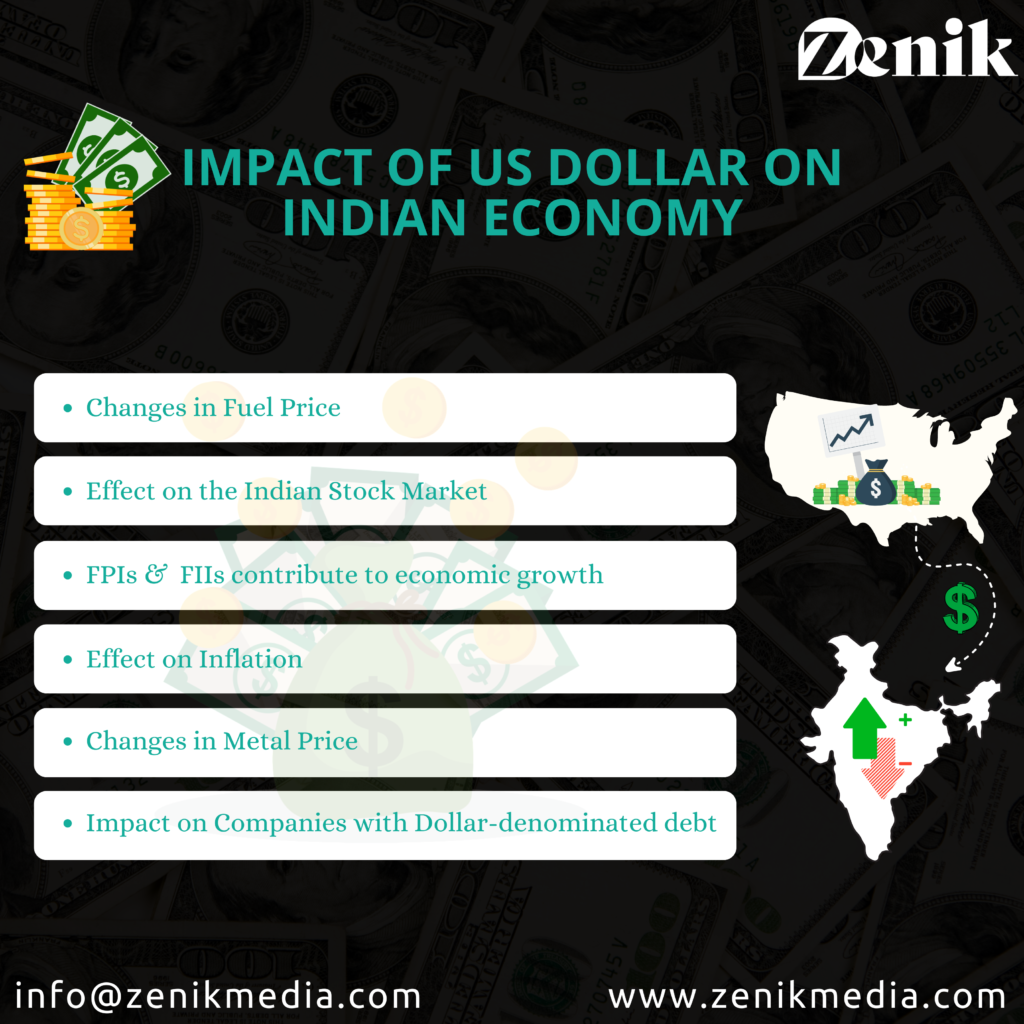Impact of US Dollar on Indian Economy

The US economy is one of the strongest economies, making the US dollar one of the world’s muscular currencies. The US dollar is a global currency; it is accepted all over the world for global trade. As per the data issued by the international monetary fund at the back of the last quarter of 2019, the US dollar accounts for about 60% of the foreign exchange reserves in the central banks of most nations. Moreover, about 90% of forex trading and 40% of the aggregated debt of the planet get allocated in dollars.
US dollar index calculates the dollar’s worth against six of the world’s giant currencies: the British pound, Japanese yen, Swedish krona, Canadian dollar, dollar and the Swiss franc. If the index is high, the dollar accumulates well-performed, while a low index denotes a weak dollar. Though the Indian rupee does not feature on the index, when the dollar’s index changes corresponded to other currencies, it affects the Indian economy.
Any rise or drop in the dollar price has far-reaching effects on the economies of other countries, including India. If we talk about the Indian economy, the dollar price actions profoundly impact different parts of the economising, collectively impacting the economy as a whole.
If the US dollar’s worth rises or falls, here’s how it affects the Indian economy:
- Differences in fuel price –
Fuel and oil commodities get traded in dollars. India is the biggest importer of natural oil, and any change in the dollar index involves crude oil costs and thus the Indian economy. If the dollar index climbs, crude oil and other entities become costlier. It improves the import cost and forms a deficit in India’s current account. Moreover, it also impacts the profitability of oil companies, oil importers, and oil refineries. The opposite holds if the dollar index drops.
2. Impact on the Indian stock market –
If the index drops, the dollar dilutes, and the INR values. As such, foreign investors get the chance to reap higher returns on their investments in India. It directs to an inflow of foreign institutional investment and foreign portfolio investment. Due to the influx of these two, there is buying pressure in the stock market, and the Indian stock market booms and becomes bullish.
3. FPIs and FIIs contribute to financial gain –
With a falling dollar index, foreign investors discover India as a lucrative investment avenue to earn higher returns on their acquisitions. Such as FPISs and FIIs flow into the Indian economy and donate to economic growth. The flow of capital to businesses from their global joint venture associates rises as FPIs and FIIs boost. It permits companies to expand and develop themselves. Exports also increase, leading to a favourable ratio of payments in the country.
4. Impact on inflation –
The dollar index also affects the inflationary trend in India. An expansion in the dollar index makes the dollar powerful and depreciates the significance of the INR. A weekend rupee makes imports more expensive and affects India inc.s profitability due to improved production costs. Advanced costs lead to inflation, and the prices of goods and services rise much to the detriment of customers. Thus, the overall GDP is affected and suffers a downshift when the dollar strengthens.
On the other hand, for the businesses employed in exports, an increasing dollar index is favourable because they can earn a higher revenue in times of the US dollar. Pharmaceutical and IT sector corporations that mainly export their goods and services become more beneficial when the dollar index boosts and vice-versa.
5. Differences in metal costs –
History has demonstrated that gold prices move inversely with the cost of the dollar. So, if the dollar index boosts and the dollar appreciates, the price of gold would drop and vice-versa. This price activity of gold hits the demand and supply of gold and, as such, affects the Indian economy.

6. Effect on businesses with dollar-denominated debt –
Many corporations have borrowed dollar-denominated debt for their cost-effectiveness. Such businesses get instantly affected if the dollar increases. A strong dollar confirms costly to businesses having dollar-denominated debt as they have to shoot out more in INR to refund their debt. It, therefore, affects the profitability of such companies negatively and might lead to a financial crunch or even bankruptcy.
US dollar, therefore, affects all parts of the Indian economy largely. It would help if you comprehended this effect since it affects you, too, the customer. The dollar’s impact on the stock market will affect your investments. Moreover, the dollar moves inflationary trends too. It would affect your monthly funding and consumption practices.
